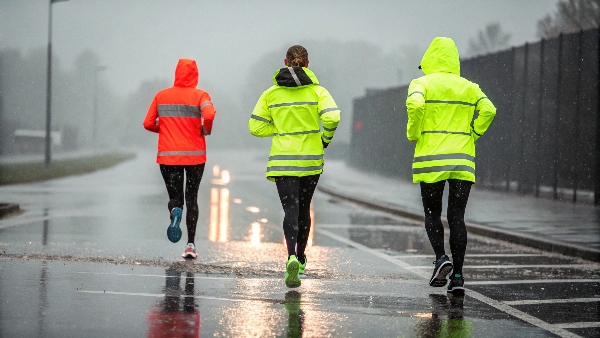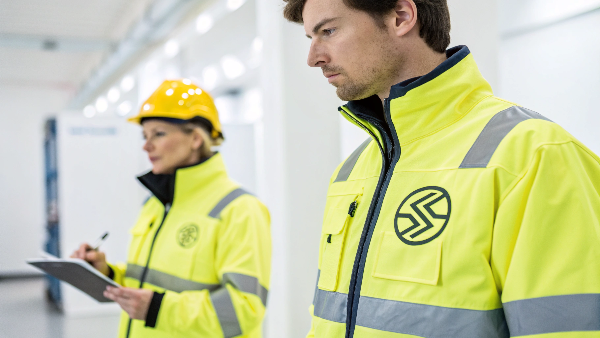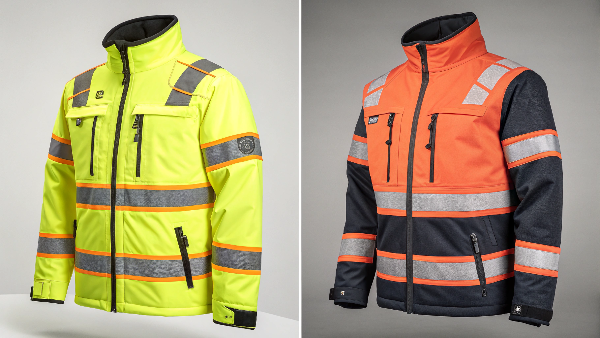Running in dim light is risky. Drivers might not see you. Imagine a close call, or worse. A running vest with lights can dramatically boost your visibility, keeping you safe.
A running vest with integrated lights makes you much easier to see. It uses multiple light points, often with 360-degree illumination. This helps drivers and others spot you from further away, especially when it's dark or visibility is poor, enhancing safety.
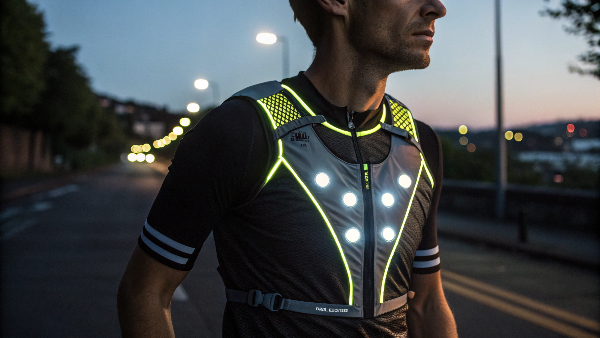
You understand the basic idea. But there is more to how these vests keep you safe. We want you to be fully informed. Let us look closer at what makes these vests so effective and what you should consider when choosing one. We believe that by understanding the technology and design, you can make the best choice for your safety.
What makes a vest high-visibility?
Not all bright vests are truly "high-visibility." Some offer a false sense of security. Choosing the wrong vest means you are still at risk on the road. Understanding key features ensures you pick a genuinely protective vest.
A true high-visibility vest1 uses specific fluorescent materials for daytime brightness. It also has retroreflective tapes2 that shine brightly when hit by headlights at night. Compliance with standards like EN ISO 20471 or ANSI/ISEA 1073 is crucial for guaranteed performance.
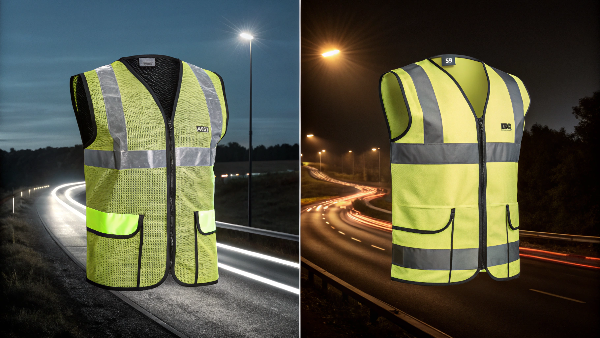
When we at Vissafety talk about high-visibility, we are serious. It is not just about a bright color. It is about science and safety standards. There are two main components that work together. First, the fluorescent material is the bright fabric itself. It reacts with UV rays from sunlight. This makes it appear to glow, especially during dawn and dusk. Common colors are fluorescent yellow-green, orange-red, and red. Second, retroreflective material, usually silver tapes, is vital. These tapes do not produce their own light. Instead, they bounce light from an external source, like car headlights, directly back to that source. This makes you incredibly visible to drivers in low-light conditions. For a vest to be certified high-visibility, like those meeting ANSI/ISEA 107 (common in the US) or EN ISO 20471 (Europe), it must meet minimum requirements for both the amount of fluorescent material and retroreflective tape, and their placement. As a manufacturer since 2007, Vissafety ensures all our certified hi-vis clothing strictly adheres to these global standards. Our industry-leading laboratory with over 75 testing devices helps us guarantee this compliance. This commitment to quality is why clients trust us.
| Feature | Description | Importance for Visibility |
|---|---|---|
| Fluorescent Material | Bright fabric (yellow, orange, red) that glows in daylight/low light. | Daytime, dawn, dusk visibility |
| Retroreflective Tape | Material that reflects light directly back to its source (e.g., headlights). | Night-time, low light visibility |
| Coverage Area | Minimum area of fluorescent and reflective material required by standards. | Overall conspicuity |
| Placement | Strategic placement of tapes for 360-degree visibility. | All-around detection |
| Certification | Compliance with standards like ANSI/ISEA 107 or EN ISO 20471. | Guaranteed safety performance |
What is the best visibility vest for running?
So many running vests exist. Finding the "best" one feels overwhelming. You might buy one that is uncomfortable, ineffective, or does not last. Knowing key features helps you choose a vest perfect for your runs.
The best visibility vest for running4 is lightweight, breathable, and fits well without chafing. It should have both bright fluorescent material for daytime and effective reflective elements for nighttime. Integrated LED lights offer a significant advantage, providing active illumination.
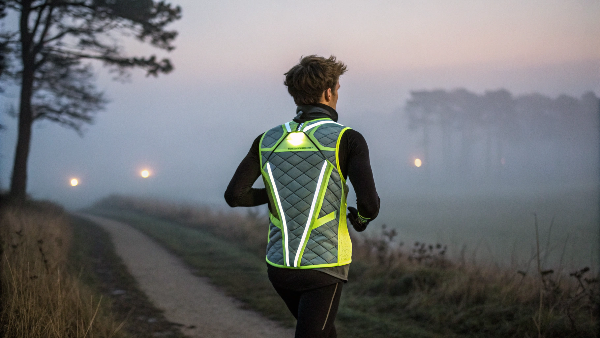
Choosing the "best" running vest really depends on your specific needs, but some features are universally important. At Vissafety, when we design running vests, even custom ones for different brands, we focus on these. Comfort is absolutely key. If a vest is not comfortable, you simply will not wear it. Look for lightweight materials that will not weigh you down during your run. Breathability is also crucial, especially for longer distances or in warmer weather, to help manage sweat and prevent overheating. An adjustable fit ensures the vest stays snug without bouncing or causing chafing.
Next, consider the visibility features. We have already discussed fluorescent and retroreflective materials. For running, especially in urban or suburban areas with traffic, integrated LED lights5 are a game-changer. These provide active illumination. This means you are lit up even if there are no headlights pointing directly at you. Many modern running vests offer 360-degree light coverage, which is ideal. Other practical things to consider are battery life for the lights – are they rechargeable or easily replaceable? – and whether you need pockets for keys, a phone, or energy gels. Durability is also important; you want a vest that can handle regular use and washing. We, at Vissafety, produce a wide range of vests, and our strength in customization means clients can get exactly what their market needs. We can tailor designs, for example, to include specific pocket placements or unique reflective patterns, all while ensuring the products remain compliant with safety standards.
| Feature | Why it's important for a running vest | Vissafety Consideration |
|---|---|---|
| Lightweight | Does not hinder performance or cause discomfort. | We use advanced, light materials. |
| Breathable | Prevents overheating and manages sweat effectively. | Focus on innovative fabric technology. |
| Adjustable Fit | Ensures comfort, prevents chafing, and stays securely in place. | Multiple adjustment points designed. |
| Integrated Lights | Active illumination for superior visibility in all low-light conditions. | A key feature in many of our designs. |
| Reflectivity | Passive illumination when headlights or other lights strike it. | High-quality, strategically placed tape. |
| Fluorescent Color | Enhances daytime and twilight visibility significantly. | Standard and custom color options. |
| Durability | Withstands regular use, sweat, and washing cycles. | Quality materials and construction. |
| Pockets | Convenience for carrying essentials like keys or phone. | Customizable based on client needs. |
Why is a reflectorized vest important?
You might think bright clothes are enough. Reflectors could seem like just an extra. But without reflectors, you are nearly invisible to drivers at night. That is a huge risk. Understanding how reflectors work shows their life-saving importance.
A reflectorized vest is vital because its retroreflective material bounces light directly back to the source, like car headlights. This makes you stand out dramatically in the dark, significantly reducing the risk of accidents when visibility is poor.
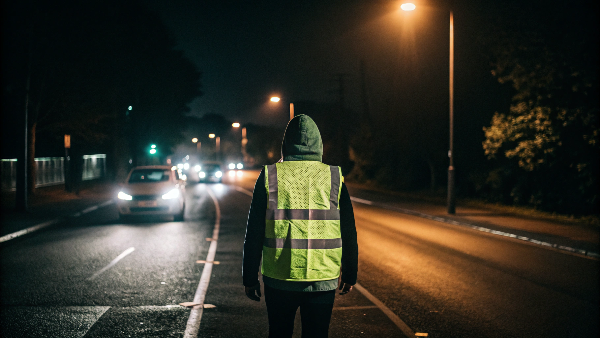
The importance of a reflectorized vest, especially for activities in low-light conditions such as running at night or early morning, cannot be overstated. It is a simple yet highly effective piece of safety equipment that significantly enhances your chances of being seen. The real magic lies in the "retroreflective" material used in these vests. Unlike a simple mirror that bounces light away at an angle, or a plain white surface that scatters light, retroreflective materials are engineered with tiny glass beads or microprisms. These structures are designed to catch light from an external source, like a car's headlights, and reflect it directly back towards that original source.
Imagine this scenario: a driver is in a car at night with their headlights on. If you are wearing a vest with good quality retroreflective tape, that light beam hits the tape and is sent straight back to the driver's eyes. You effectively appear to glow brightly within their field of vision. Without it, you are just a dark shape against a dark background, easily missed until it is potentially too late for the driver to react safely. This principle is crucial not just for runners, but for construction workers, cyclists, emergency responders, and anyone who needs to be visible near traffic or in unlit areas after dark. At Vissafety, we ensure the reflective tapes used on our garments meet high performance standards for reflectivity and durability. Our triple QC process helps maintain this quality, providing peace of mind.
What is the purpose of high-visibility retro reflective vest?
"High-visibility" and "retroreflective" sound technical. You might wonder what the real point is. Not knowing the purpose means you might overlook a key safety feature when choosing gear. The purpose is simple: to make you seen and keep you safe.
The main purpose of a high-visibility retroreflective vest6 is to make the wearer maximally conspicuous in all light conditions, day and night. It combines fluorescent material7 for daytime and retroreflective elements for nighttime, preventing accidents by ensuring others see you clearly.
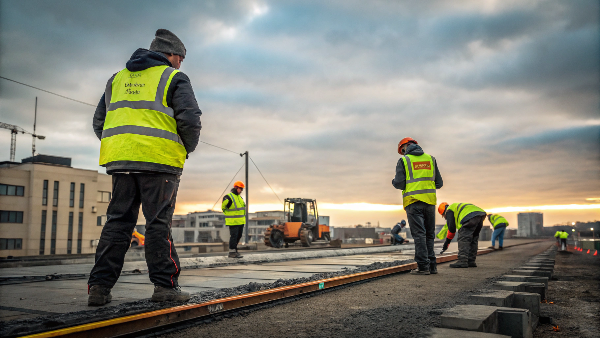
The purpose of a high-visibility retroreflective vest is very straightforward: to save lives and prevent injuries by making people exceptionally easy to see. These vests are specifically engineered to grab attention in various lighting and environmental conditions.
During the daytime, the fluorescent part of the vest is key. This bright material, usually fluorescent yellow-green, orange-red, or red, interacts with the sun's invisible UV rays. It absorbs this UV light and then re-emits it as visible light. This process makes the fabric appear extraordinarily bright, almost as if it is glowing. This effect helps you stand out distinctly from complex backgrounds, which is especially important during dawn and dusk when light levels are changing rapidly.
At night or in other low-light conditions (like heavy rain, fog, or inside dimly lit warehouses), the retroreflective strips on the vest do the critical work. As we have discussed, these strips contain materials that reflect light from sources like vehicle headlights directly back to the driver or light operator. This makes the wearer appear as a bright, often human-shaped, light source in the darkness. The combination of these two types of materials is what makes these vests so effective across diverse environments – from busy construction sites and dark roadways to urban running paths. For us at Vissafety, our mission is "to provide top-quality, stylish, and customizable High Visibility Clothing to empower our clients’ businesses globally." A core part of fulfilling this mission is ensuring every vest serves its primary purpose: enhancing wearer safety through superior visibility. This commitment naturally aligns with our adherence to global compliance standards like EN ISO 20471 and ANSI/ISEA 107.
What does running with a 20 pound vest do?
You have probably heard about weighted vests for training. You might wonder how they relate to visibility. Focusing only on the weight training aspect might make you forget about safety on your run. Weighted vests add intensity, but visibility remains just as crucial.
Running with a 20-pound vest is a form of resistance training. It increases workout intensity, helps build strength, and burns more calories. It does not directly improve visibility; for that, you still need a separate high-visibility running vest or features.

Running with a weighted vest, such as a 20-pound one, is primarily about boosting your fitness level and training intensity. It is a tool designed to make your workouts more challenging. The added weight forces your muscles, bones, and cardiovascular system to work harder than they normally would during an unweighted run. This can lead to several physical benefits over time. These include increased muscular strength and endurance, particularly in the legs and core. You will also likely experience a higher calorie burn during your workouts because your body is expending more energy to move the extra load. Additionally, weight-bearing exercises like running with a weighted vest can contribute to improved bone density.
However, it is very important to understand that a standard weighted training vest is typically not designed with visibility in mind. Its main purpose is to provide resistance for training, not to make you conspicuous to others. So, if you are running with a weighted vest, especially outdoors in low-light conditions – like early mornings, late evenings, or overcast days – you absolutely still need to think carefully about being seen by drivers, cyclists, and other pedestrians. This is where a lightweight, high-visibility running vest, perhaps one with integrated LED lights, becomes essential. You would typically wear this over or in addition to your weighted vest. Safety should never be compromised for training intensity. While we at Vissafety specialize in high-visibility apparel, we recognize the diverse needs of active individuals. If someone were looking to combine weighted training with outdoor running, they would need to ensure their visibility gear fits comfortably and effectively over their training gear. It's a different product for a different primary purpose, but the fundamental need for visibility if you are near traffic or in dim conditions is constant and critical.
What color vest means high visibility?
Many bright colors exist. You might wonder which ones actually count for "high visibility." Choosing a trendy bright color that is not truly hi-vis offers a false sense of safety. Specific fluorescent colors are standardized for maximum daytime visibility.
The primary colors for high-visibility vests are fluorescent yellow-green, fluorescent orange-red, and sometimes fluorescent red. These specific shades are scientifically chosen because they are most effective at catching the human eye during daylight hours, dawn, and dusk.
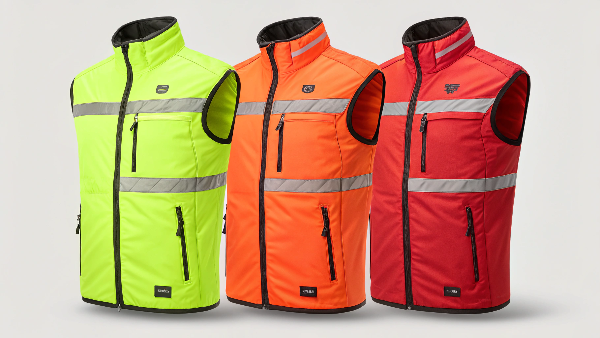
When it comes to genuine high visibility, not just any bright color will do the job effectively or meet safety standards. Specific colors have been scientifically researched and proven to be the most conspicuous to the human eye, especially during daylight hours and in conditions with some ambient light like dawn or dusk. The official safety standards, such as ANSI/ISEA 107 in North America and EN ISO 20471 in Europe, clearly define these permissible colors for background materials of safety garments.
The most common and effective high-visibility colors are:
- Fluorescent Yellow-Green: This color is often considered the brightest and most easily detectable across a wide range of environments. It provides excellent contrast against complex urban backgrounds and natural scenery.
- Fluorescent Orange-Red: This color also offers outstanding daytime visibility. It can provide particularly good contrast in environments with a lot of green foliage or in snowy conditions.
- Fluorescent Red: While sometimes less common as the sole background color in certain regions or for specific garment classes, fluorescent red is also a recognized high-visibility color that offers good conspicuity.
Why these specific fluorescent shades? They work through a process called fluorescence. They absorb invisible ultraviolet (UV) light from the sun and then re-emit that energy as visible light. This makes the fabric appear exceptionally bright, almost as if it is glowing, and far more vibrant than conventional colors. This phenomenon is crucial for being seen from a distance during the day, and it is especially effective during dawn and dusk when ambient light is low but there is still sufficient UV radiation. At Vissafety, we offer these standard high-visibility colors in our products to ensure full compliance and maximum safety. However, thanks to our extensive customization capabilities, we can also incorporate other colors for branding purposes or stylistic accents, as long as the garment still meets the minimum area requirements for the certified fluorescent material. It is about achieving a balance between uncompromised safety compliance and meeting our clients' specific branding and design needs.
| Hi-Vis Color | Primary Benefit | Best For Typical Environments |
|---|---|---|
| Fluorescent Yellow-Green | Highest daytime conspicuity against most backgrounds. | Urban areas, roadways, varied conditions. |
| Fluorescent Orange-Red | Excellent daytime visibility, offers good contrast. | Wooded areas, construction, snow. |
| Fluorescent Red | Good daytime visibility, strong visual impact. | Often used in specific industries or regions. |
What is the purpose of a reflective vest?
You see people wearing reflective vests in various situations. You might wonder what exactly they do. Not understanding their specific function might mean you misuse or undervalue them. Reflective vests are specifically designed for nighttime and low-light safety.
The primary purpose of a reflective vest is to make the wearer highly visible in dark or low-light conditions by reflecting light from external sources, like vehicle headlights, directly back to that source, making the wearer appear bright and easily identifiable.
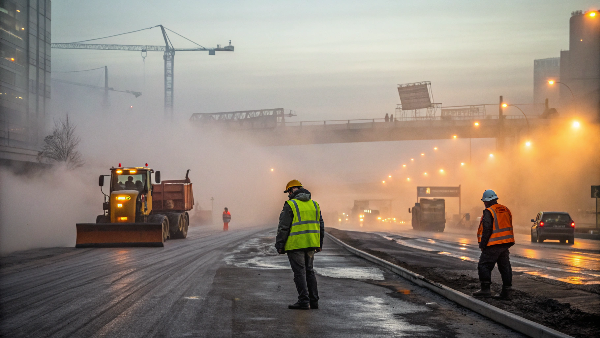
The purpose of a reflective vest centers entirely on enhancing a person's visibility specifically when it is dark, or when ambient light levels are very poor, such as during heavy rain, dense fog, or inside unlit structures. Unlike fluorescent materials, which need some UV light (typically from the sun) to "glow" and provide daytime visibility, reflective materials work by bouncing back artificial light sources.
The key technology that makes these vests so effective is called "retroreflection." Think of the silver-gray tapes commonly found on these vests. These tapes are not just shiny; they are embedded with either tiny glass beads or microscopic prisms. When a beam of light, for example from a car's headlight, strikes these tapes, the light is not scattered randomly in all directions like it would be from a plain white surface. Instead, due to the special structure of the beads or prisms, the light is directed precisely back towards its original source – in this case, the car and the driver's eyes. This makes the reflective strips appear intensely bright to the driver, effectively outlining the wearer's silhouette. This is incredibly important because, without such a vest, a person in dark clothing is practically invisible to a driver at night until they are dangerously close. A good reflective vest can increase the distance at which a driver can see a pedestrian or worker by hundreds of feet, giving the driver much more valuable time to react, slow down, or maneuver to avoid a collision. At Vissafety, we emphasize the quality and strategic placement of reflective tapes on all our safety apparel. Our products are designed to meet or exceed global standards like EN ISO 20471 and ANSI/ISEA 107, which specify minimum amounts and precise placement of this material to ensure 360-degree visibility. It’s a relatively simple concept in principle, but one that plays a critical role in saving lives daily in countless low-light environments.
What is a vest designed to be highly visible?
With so many different types of vests available, you might ask what truly defines one as "highly visible." Confusion can lead to choosing a vest that does not offer the proper level of protection. Key design elements work together to maximize how well you are seen.
A vest designed to be highly visible8 strategically combines bright fluorescent fabric9 for daytime and twilight conspicuity with retroreflective materials for nighttime and low-light visibility. Its overall design ensures the wearer stands out against various backgrounds and in all lighting conditions.
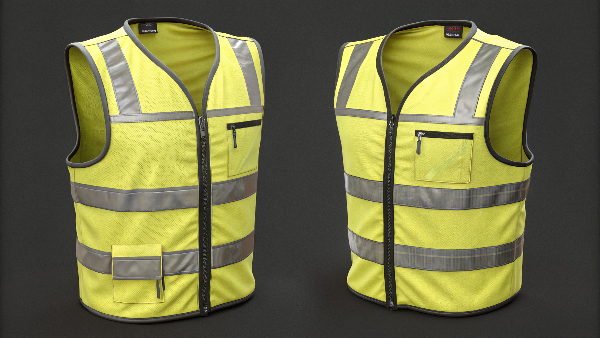
A vest designed to be genuinely "highly visible" is much more than just a brightly colored piece of clothing. It is an engineered safety garment, thoughtfully constructed to maximize the wearer's conspicuity across a wide range of conditions. At Vissafety, when we design and manufacture such vests, including specialized ones like running vests with integrated lights, we focus on a specific combination of critical elements. These elements work synergistically to achieve the highest possible level of visibility.
These crucial elements include:
- Background Material: This is the fluorescent fabric that makes up the main body of the vest. As we have discussed, standard colors are fluorescent yellow-green, orange-red, or red. The amount of this material used is precisely specified by safety standards like ANSI/ISEA 107 or EN ISO 20471. Its primary job is to make the wearer stand out clearly during daylight hours, and it is particularly effective during the challenging light conditions of dawn and dusk.
- Retroreflective Material: These are typically the silver-gray tapes or strips that shine brightly when hit by an external light source in dark conditions. Their placement on the vest is not random; it is strategically planned, often in patterns that outline the human form (for example, over the shoulders and around the torso). This helps to ensure 360-degree visibility and allows observers to quickly recognize the wearer as a person.
- Design and Coverage: International safety standards dictate not only the types of materials but also the minimum surface areas required for both fluorescent background material and retroreflective tape. They also provide guidance on how these materials should be arranged on the garment to ensure optimal visibility from all angles.
- Contrast: In some designs, a darker contrasting color (like navy or black) is used alongside the fluorescent material, often around the edges or in specific panels. This can help to make the fluorescent color appear even brighter and more defined against certain backgrounds.
For running vests that also feature integrated LED lights, these lights add an active layer of high visibility. This further enhances the passive visibility provided by the fluorescent and reflective materials, making the wearer even more noticeable, especially in very dark or distracting environments. Our mission at Vissafety is to provide top-quality, stylish, and customizable High Visibility Clothing. This means ensuring every hi-vis vest we produce, whether it is a standard work vest for a construction site or a specialized running vest for an athlete, truly fulfills its fundamental purpose of keeping people seen and safe. This unwavering commitment to quality and compliance is why our clients, including experienced B2B buyers and distributors globally, have trusted our expertise and products since 2007.
Conclusion
A running vest with lights drastically improves your visibility. It uses active illumination and passive reflective materials. This combination works day and night to keep you safer on every run.
-
Explore this link to understand the essential features that make a vest truly high-visibility, ensuring your safety on the road. ↩
-
Learn how retroreflective tapes work to improve visibility at night, making them crucial for safety in low-light conditions. ↩
-
Discover the ANSI/ISEA 107 standards to ensure your high-visibility clothing meets safety requirements for optimal protection. ↩
-
Explore this link to discover top-rated visibility vests that enhance safety and comfort during your runs. ↩
-
Learn how integrated LED lights can significantly enhance your visibility and safety while running in low-light conditions. ↩
-
Explore the benefits of high-visibility retroreflective vests to understand how they enhance safety in various environments. ↩
-
Learn how fluorescent materials work to improve visibility and safety in different lighting conditions. ↩
-
Explore this link to understand the essential features that make a vest highly visible, ensuring safety in various conditions. ↩
-
Discover how fluorescent fabric works to improve visibility, especially during daylight and twilight, ensuring safety for wearers. ↩

